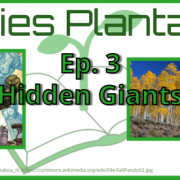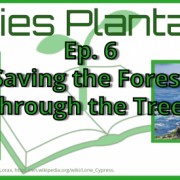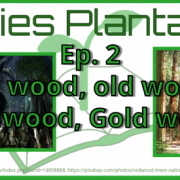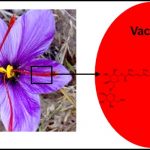Stories Plantarum E5: Upside Down and Underground Transcript

Episode Description:
This episode gets down to the roots of an interdimensional monster with floral fangs and a real-life parasitic plant that looks just as ferocious.
Featuring the Demogorgon from Stranger Things and Hydnora africana.
Transcripts can be found here: https://community.plantae.org/…
Follow and get in contact on social media!
Twitter: @PlantarumPod
Facebook: facebook.com/PlantarumPod
Hosted by Rebecca Hayes, @BigGirlPlants on Twitter. Keep up to date on this podcast and other projects on https://community.plantae.org/…
Prefer to listen to the episode? Links below!
Apple Podcasts (rate and subscribe if you enjoy the show!)
Soundcloud (listen in browser, no programs to download)
-Intro music “Age of Technology” by DP Music fades in-
Welcome back to Stories Plantarum, the podcast all about fabulous fantastical plants from sci-fi and fantasy and real-life plants that seem out of this world. I’m your host Rebecca Hayes, and today we’re discussing an interdimensional monster with a flower-like mouth and a subterranean plant that bursts above ground with a monstrous flower. A quick note before we begin, transcripts for the first four episodes are now available on community.plantae.org in the Stories Plantarum Transcripts collection along with episode graphics including image descriptions. I’ll post a link in the description if you’d like to check it out. Accessibility is very important to me, so if there is anything that I could be doing to make this podcast easier to interact with please let me know on Twitter or Facebook @PlantarumPod, or in the comments section on community.plantae.org. By the time this episode is up, the transcript for this one will be available too. Also, for those of you that haven’t yet seen it and are worried about spoilers, this episode discusses major plot points from seasons 1-3 of the Netflix original Stranger Things. Alright, as always thanks for listening and now let’s dig in to Stories Plantarum, Episode 5: Upside Down and Underground.
-Song “TINTINABUL” by C_C Fades in-
We start this story travelling back in time to Hawkins, Indiana in the year 1983. Hawkins is a quaint midwestern town that happens to be home to the US Department of Energy’s Hawkins National Laboratory, a research facility headed by Dr. Martin Brenner, a known perpetrator of unethical experiments under the CIA’s Project MKUltra. Project MKUltra was a real-life operation focused on researching methods for mind control with experiments that crossed the lines of legality on many occasions. After details of the project were made public, all experiments at the Hawkins National Laboratory were supposed to cease, however Dr. Brenner wasn’t quite ready to give up on his progress, however unethical and illegal it may have been.
Dr. Brenner crossed an even further line by kidnapping the demonstrably psychic child that was born of one of the victims of the MKUltra program to use in clandestine psychological experiments. This child, renamed Eleven by Brenner, had psychic and telekinetic abilities and was once placed in a sensory deprivation tank to remotely spy on Russian operatives. While traversing through the in-between space called the Void, she happens upon an interdimensional monster that tries to attack her. This encounter unintentionally leaves a gate between the dimensions open to allow the monster to creep into the human world.
The monster stood 6-10 feet tall and was humanoid in form but lacked facial features besides a gigantic lobed mouth that unfurled like the petals of a red flower and were lined with rows upon rows of razor-sharp teeth. Instead of fingers, the monster had elongated claws and its entire body was glistening and scaly. The monster, which lacks a formal scientific name, was nicknamed “The Demogorgon” by four young boys in Hawkins after a Dungeons and Dragons character that is known as the prince of demons.
The Demogorgon hails from the Upside Down, an alternate universe ruled by the Mind Flayer, a sort of super Demogorgon that controls hordes of lesser monsters and organisms as a hive mind. This world is dominated by a dark, dank, and swampy environment in cold and unwelcoming shades of blue to black.
Several humans have entered the Upside Down and lived to tell the tale, including Will Byers, who was actually possessed by the Mind Flayer for a period of time, Nancy Wheeler, Jim Hopper, and Joyce Byers. Despite those characters making it out alive, the Upside Down is typically treacherous and inhospitable to humans.
The Demogorgon has supernatural strength and is able to withstand bullets and blunt force trauma from a studded baseball bat. It seems to have a weakness to heat and flame and is injured by burns, however it still wasn’t defeated until Eleven gives it a psychic beat down and tears it to smithereens.
-“Universal Police” by Synapsis fades in-
The Demogorgon has an interesting lifecycle made up of 6 distinct stages. Its life begins upon deposition of an egg into a living host. This is achieved through motile, tentacle-like vines controlled by the Mind Flayer that function like ovipositors in insects, which are specialized structures that are used to force eggs into or onto a host. These vines are seen engulfing Barbara Holland after being dragged into the Upside Down by the Demogorgon. Unfortunately, Barbara met a very untimely death during the ordeal, may her soul rest in peace.
The vines were also seen entering Will Byer’s throat, which were forcibly removed upon his rescue by his mother and Hopper. It is also implied that the Demogorgon can use pumpkins as a host, however this is never explicitly shown on screen.
As seen in Will, the egg hatches into a yellow and green slug-like larva inside the host and is either vomited up in Will’s case or presumably bursts or eats its way out as evidenced by the exploded field of sickly pumpkins that Hopper found after the Demogorgon’s appearance.
The next stage is the pollywog stage, where the baby Demogorgon resembles a palm-sized tadpole with an elongated tail and stubby forelimbs. It is incredibly sensitive to light and heat. This is the stage in which Dustin Henderson finds one foraging in the trash and brings it home as a pet named Dart after tempting it with a candy bar.
After that is what some call the “frogogorgon” stage, which progresses similar to the tadpole to frog transition. The adolescent Demogorgon sprouts hindlegs and begins growing rows of sharp teeth. The Demogorgon’s skin at this stage turns a dark green color.
As the developing Demogorgon continues to feed, it molts and emerges a creature slightly larger than a housecat. The species’ iconic petal shaped mouth is apparent at this stage and the Demogorgon becomes an obligate carnivore. So, no more candy bars for Dart. At this point, the Demogorgon is able to withstand more light and heat and can walk in sunlight unharmed.
The Demogorgon continues to grow to the size of a large dog, earning this stage the nickname “Demodog”. The Demogorgon is not yet fully an adult, but can now overpower a human adult, quickly dig tunnels, and climb impossibly steep surfaces. While bullets can kill a Demodog, they can withstand several shots before succumbing.
After one final molt the Demogorgon is full grown. It can rip doors off of their hinges, smell a drop of blood in another dimension, and is nearly indestructible.
To find the origins of the Demogorgon, we must travel back much farther than 1983.
Before Dungeons and Dragons inspired the name of the interdimensional monster in Stranger Things, Demogorgons plagued the human imagination for centuries.
Some of the most famous writers in history have included the Demogorgon in their works.
The Demogorgon was mentioned in English poet John Milton’s 1667 epic Paradise Lost as “the dreaded name” and was thought to be the ancestor of all gods in ancient mythology.
Poet Percy Shelley includes a passage describing the Demogorgon in his 1820 drama Prometheus Unbound:
Filling the seat of power, and rays of gloom
Dart round, as light from the meridian sun,
Ungazed upon and shapeless; neither limb,
Nor form, nor outline; yet we feel it is
A living Spirit.
Finally, in Herman Melville’s 1851 novel Moby Dick, Captain Ahab’s first mate Starbuck refers to the whale that terrorizes them as a Demogorgon.
Funny enough, allegedly the name Demogorgon actually originated from an ancient typo: a well-known Christian scholar Lactantius Placidus was reviewing a Roman poet’s epic in the 5th century and wrote “Demogorgon, the supreme god, whose name it is not permitted to know.” Greek scholars today think that he probably meant “Demiurge”, the word for the creator of the physical world, but misspelled it. Future writers found the sentence ominous, which inspired the Demogorgon’s demonic history.
Let this serve as a lesson to always spellcheck your emails, or else your typo may end up haunting literature for over a thousand years and eventually terrorizing an entire midwestern town.
Interestingly, the character designer for the Demogorgon Aaron Sims has said that he actually used flower petals and the mouth of a snapping turtle for inspiration. Although he doesn’t credit a particular plant for the design, this next plant seems straight out of the Upside Down.
-“Organisms” by Chad Crouch fades in-
Native to parts of South Africa, Hydnora africana is certainly one of the strangest looking plants on the planet. Its Latin name comes from its resemblance to the genus of mushrooms Hydnum and its African origins. The common name of this bizarre plant is Jakkalskos in Afrikaans which means “Jackal Food”, because the fleshy flowers are a common snack of the native canids. Not only are they a favorite food of Jackals, but they are also commonly foraged by birds, small mammals, porcupines, and moles.
Hydnora africana can be difficult to find in the wild because it spends nearly its entire life underground attached to the roots of another plant. Hydnora is a parasite of several Euphorbia species. Underground, the plant is made up of fleshy, wart-covered stems that completely lack leaves and darken from a brown-gray color black at maturity. The Hydnora’s underground stems produce a tangle of roots that hunt down and encircle those of the Euphorbia and then produce an enzyme that partially dissolves the host plant’s roots to tap in to steal their water and nutrients. Hydnora then waits in the darkness beneath the soil gaining strength through its host for years at a time until it is ready to burst into our dimension.
At first, the Hydnora flower begins to emerge as a mushroom-like bulge near the base of the Euphorbia host. The flower bud is dark brown, spherical, and bumpy on the outside and is similar in color and texture to a leather American football. The flower is made up of 3 or 4 thick lobes that are fused at the base of the flower but slowly peel apart to reveal the brightly colored interior and the stinky white bait bodies as the flower matures.
-“Downfall” by Six Umbrellas begins-
At first, the flower opens only a tiny bit and is held together by strong white, threadlike fibers that are densely packed to allow only small beetles, which are attracted to the pungent bait bodies, into the depths of the flower. The inside of the flower is bright orange to salmon and covered in short, downward-facing bristles to discourage escape.
The insects that make their way in are in for an intense several days, as the flower is designed to entrap its pollinators for a short period to ensure adequate amounts of pollen are picked up before they are freed. The interior of the flower is covered in downward facing slippery hairs and acts like a double dipper slide for beetles. First, the beetles slide from the bait bodies down onto the anthers where they are covered with pollen. Next, the beetles drop even further into the depths of the flower onto the spongy landing pad that is the stigma. Pollen is transferred from the disoriented beetle onto the stigma and pollination is complete.
In a day or two, the flower opens completely to release the puzzled pollinators and revealing a morphology that looks strikingly like the mouth of the Demogorgon. After successful pollination, the plant spends up to 2 years forming an underground fruit that is similar in taste and texture to a potato and is edible to humans.
In addition to being a delicacy for animals, several traditional Afrikaans cookbooks feature recipes starring foraged Jakkalskos. Supposedly, the flowers have a custardy sweetness to them when roasted and is delicious in rich desserts. Also, Hydnora extracts have been used to treat several ailments including run of the mill diarrhea, dysentery, kidney and bladder issues, and acne. The astringent properties of the Hydnora made it useful in the traditional tanning and preserving of fishing nets.
Hydnora is famously nearly impossible to cultivate. The first successful cultivation was in 1979 from seeds that were collected in Robertson, South Africa, by Sherwin Carlquist in 1973. Seeds were potted alongside the Euphorbia host and years later, a flower miraculously emerged from the soil. Wildly enough, halfway across the world in California, dung beetles still flocked to the flower’s noxious fumes.
So, my apologies if you were hoping to have a Hydnora of your own. You may have a better chance trying to open an interdimensional rift and conjuring a real Demogorgon.
-outro music “Business Talk” by DP Music fades in-
Alright, that’s all I have for this episode of Stories Plantarum. If you enjoyed the show, please rate, comment, and subscribe on iTunes, it helps other people find the show. Follow us on twitter @PlantarumPod and facebook.com/PlantarumPod, feel free to reach out with any feedback or suggestions for future episodes. You can also find infographics about each episode there. Full episode transcripts and graphics with image descriptions are available at community.plantae.org. I’ll be back next episode with more tales from the weird and wacky world of plants.
Stories Plantarum is written and produced by me, Rebecca Hayes. Intro music is “Age of Technology” by DP Music, and outro music is “Business Talk” by DP Music. This episode featured more songs than usual, including “TINTINABUL” by C_C, “Universal Police” by Synapsis, “Organisms” by Chad Crouch, and “Downfall” by Six Umbrellas all on the Free Music Archive. The Demogorgon comes from the Netflix original series Stranger Things created by the Duffer Brothers. Sources for the Demogorgon include several Stranger Things Wiki pages including “Demogorgon (Species)”, “The Demogorgon”, and “The Upside Down”, a dnd.wizards.com article by Shannon Appelcline titled “Demogorgon: Prince of Demons”, a Seventeen Magazine article by Tamara Fuentes titles “What Is a Demogorgon from ‘Stranger Things’?”, a ScreenCrush article by Kevin Fitzpatrick titled “‘Stranger Things’ Concept Artist Talks Demogorgon Egg, Barb”, and a MentalFloss.com article by Jeff Wells titled “The Otherwordly History of the Demogorgon”. Sources for the Hydnora background info included the South African National Biodiversity Institute profile on Hydnora africana, the Korean Strange Plant Research Institute’s Hydnora africana page, the Botanical Society of America’s Parasitic Plant Pages article on Hydnora africana, a PBS educational video in the Gross Science Youtube series titled “The Strangest Plant in the World?!”, and an unbelievable-facts.com article by Aswathy Gopinath amazingly titled “This African flower smells like feces and looks like a scary vagina with sprouted fangs”.
-“Business Talk” fades out-

Sources:
“Demogorgon: Prince of Demons | Dungeons & Dragons.” Accessed October 8, 2019. https://dnd.wizards.com/articles/features/demogorgon-prince-demons.
“Demogorgon (Species).” Stranger Things Wiki. Accessed September 29, 2019. https://strangerthings.fandom.com/wiki/Demogorgon_(species).
FitzpatrickAugust 22, Kevin, and 2016. “‘Stranger Things’ Concept Artist Talks Demogorgon Egg, Barb.” ScreenCrush. Accessed September 29, 2019. https://screencrush.com/stranger-things-concept-art-demogorgon-upside-down-barb/.
Fuentes, Tamara. “What Is a Demogorgon from ‘Stranger Things’?” Seventeen, July 19, 2019. https://www.seventeen.com/celebrity/movies-tv/a28437324/what-is-demogorgon-stranger-things/.
“Hydnora Africana | PlantZAfrica.” Accessed September 20, 2019. http://pza.sanbi.org/hydnora-africana.
“Hydnora Africana – KSPRI.” Accessed September 20, 2019. http://www.strangeplants.org/hydnora-africana/.
“Hydnora Africana, Parasitic Plants Online – Botanical Society of America.” Accessed September 20, 2019. https://www.botany.org/Parasitic_Plants/Hydnora_africana.php.
“The Demogorgon.” Stranger Things Wiki. Accessed September 29, 2019. https://strangerthings.fandom.com/wiki/The_Demogorgon.
“The Flower Of The Hydnora Africana Looks Pretty Monstrous!” Accessed October 3, 2019. https://unbelievable-facts.com/2015/08/hydnora-africana.html.
“The Otherworldly History of the Demogorgon | Mental Floss.” Accessed September 30, 2019. http://mentalfloss.com/article/87800/otherworldly-history-demogorgon.
The Strangest Plant In The World?! Accessed October 11, 2019. https://www.youtube.com/watch?v=WBVd9Stp2s8.
“The Upside Down.” Stranger Things Wiki. Accessed October 9, 2019. https://strangerthings.fandom.com/wiki/The_Upside_Down.










Leave a Reply
Want to join the discussion?Feel free to contribute!